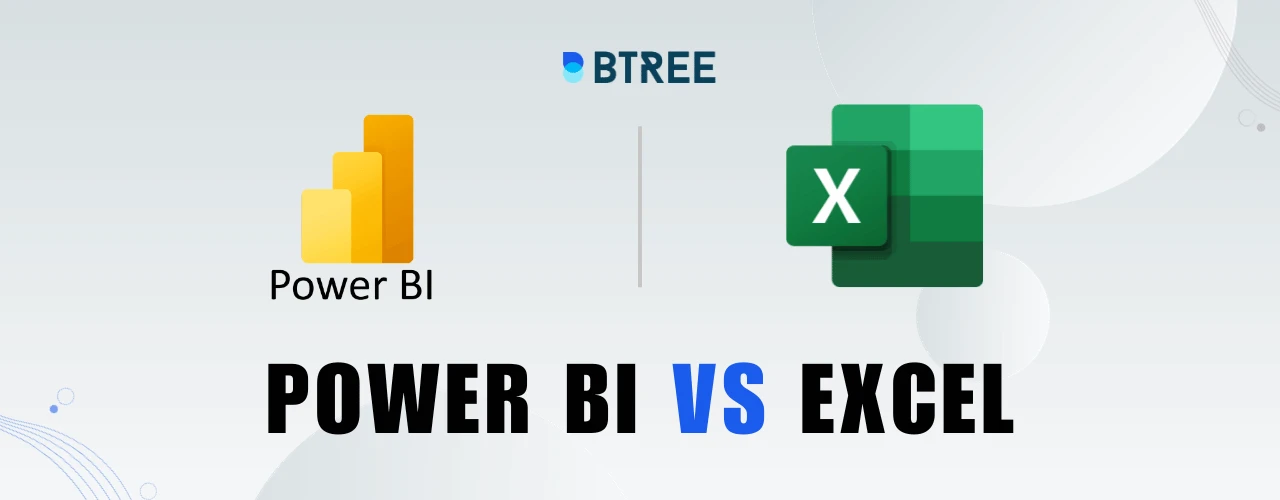
Did you know that Excel has been around since way back in 1985, while Power BI is a relatively newer tool that came into existence in 2010? So we will be comparing a past master with a fresh-faced newbie in the world of data analysis. As we begin with the comparison of Power BI and Excel, it will be surprising for you to witness the evolution of these data analysis tools and the exciting possibilities they offer.
What is Power BI?
Power BI is a powerful business intelligence tool developed by Microsoft. It enables users to analyze and visualize data from multiple sources. Through Power BI, users can create interactive reports, dashboards, and visual data representation. The Power BI tool offers various choices for data connectivity, including popular databases, cloud services, and Excel spreadsheets. Moreover, it empowers users with advanced analytical abilities, encompassing data modeling, data conversion, and the capacity to create custom calculations.
What is Excel?
Excel is a versatile software application developed by Microsoft that is widely employed for data organization, analysis, and presentation. It allows users to create virtual tables known as spreadsheets, which consist of rows and columns. Within these spreadsheets, individuals can input and manipulate numbers, text, and formulas to perform calculations, generate charts, and construct graphs. It provides a user-friendly interface with various tools and functions that help in data management and analysis.
Benefits of Using Power BI
Using Power BI offers several benefits that can significantly improve your data analysis abilities. Below we will discuss some of the benefits of Power BI.
Data Visualization
One of the primary benefits of Power BI is its ability to create visually appealing and interactive dashboards and reports. It allows users to transform complex data sets into clear, concise visuals such as charts, graphs, and maps. This visual representation makes it easier for users to identify patterns, trends, and correlations within their data.
Centralized Data
Power BI enables users to connect to various data sources, whether stored on-premises or in the cloud. By consolidating data from different sources into a single platform, it offers a comprehensive view of business operations. This centralized approach ensures accurate and up-to-date information, leading to improved decision-making based on reliable data.
Collaboration and Sharing
Power BI promotes collaboration by providing a platform for sharing reports, dashboards, and datasets with colleagues and stakeholders. This feature enhances teamwork and ensures decision-making is based on a common understanding. Moreover, Power BI supports embedding reports into websites or applications, making it easy to share insights with a broader audience.
Advanced Analytics and AI Capabilities
Power BI incorporates advanced analytics and artificial intelligence (AI) capabilities to enhance data analysis. Built-in AI features like natural language queries and machine learning algorithms enable users to extract deeper insights from their data. By leveraging these capabilities, users can perform sophisticated analysis, detect trends, predict outcomes, and uncover hidden patterns.
Data Security and Governance
Maintaining data security and governance is critical for organizations. Power BI provides robust security features that ensure data protection and compliance. With role-based access control, encryption, and data loss prevention mechanisms, Power BI safeguards sensitive information. It also supports compliance with industry standards and regulations, such as GDPR and HIPAA, helping organizations effectively meet their data privacy and regulatory requirements.
Benefits of Using Excel
Below we will explore the various benefits of using Excel so that you can leverage it to enhance your data management and analysis skills.
Flexible Data Manipulation
Excel provides a wide range of tools for data manipulation. You can sort, filter, and format data to highlight important information with Excel. Data validation ensures the accuracy of entered data, while conditional formatting allows for visual representations based on specific conditions.
Data Organization and Analysis
Excel allows you to efficiently organize, store, and analyze large amounts of data. With its spreadsheet format, you can easily input data into rows and columns, creating a structured layout that makes information retrieval. This capability benefits budgeting, inventory management, sales tracking, and project planning.
Mathematical and Statistical Calculations
Excel is equipped with a wide range of built-in formulas and functions that simplify mathematical and statistical calculations. From simple arithmetic operations to complex financial calculations, Excel can handle it all. Whether you need to calculate totals, averages, and percentages or apply statistical analysis, you can rely on Excel's powerful mathematical capabilities to save time and eliminate human errors.
Integration with Other Applications
Excel seamlessly integrates with other Microsoft Office applications, such as Word and PowerPoint. This integration allows you to import and export data between different software, enhancing productivity and facilitating data sharing. Moreover, Excel can connect to external data sources, broadening the scope of data analysis possibilities.
Ensuring Data Accuracy and Validation
Excel's data validation features ensure the accuracy and integrity of entered data. Users can define rules and restrictions, such as data type, range, or specific criteria, preventing errors and inconsistencies.
Use Cases of Power BI
With its advanced analytics capabilities, Power BI is widely utilized across industries. Here we will look into the Power BI use cases that highlight its versatility and impact across various domains.
The Use Cases of Power BI are:
Marketing Campaign Analysis
Power BI allows marketing teams to evaluate the effectiveness of their campaigns by consolidating data from digital marketing platforms, social media channels, and customer relationship systems. Through interactive dashboards, marketers can track key metrics like website traffic, lead generation, conversion rates, customer engagement, and campaign Return on Investment.
Sales and Revenue Analysis
Power BI enables businesses to comprehensively understand their sales performance by consolidating data from multiple sources, such as CRM systems, e-commerce platforms, and point-of-sale systems. With interactive visualizations and dashboards, sales teams can monitor key metrics like revenue, units sold, customer segmentation, and regional performance.
Financial Reporting and Analysis
Power BI simplifies financial reporting and analysis by aggregating financial data from diverse systems like accounting software and ERP systems. It allows finance professionals to generate dynamic financial reports, balance sheets, income statements, and cash flow statements.
Customer Analytics and Retention
Power BI helps organizations understand customer behavior and improve customer retention by consolidating data from multiple touchpoints, such as CRM systems, customer support platforms, and social media. With powerful visualizations and data exploration capabilities, businesses can gain insights into customer preferences, satisfaction levels, churn analysis, and lifetime value.
Executive Dashboards
Power BI empowers executives and senior management with real-time access to critical business metrics through comprehensive dashboards. By consolidating data from various departments and systems, executives can track overall business performance, revenue trends, profitability, customer satisfaction, and other key performance indicators.
Our Lovely Student feedback
Use Cases of Excel
Let us now explore the use cases of Excel, showcasing how this powerful spreadsheet software can streamline tasks and improve data management.
Collection and Verification of Business Data
Excel simplifies collecting and verifying business data. You can create customized data entry forms with drop-down menus, checkboxes, and validation rules, ensuring that data is entered accurately and consistently. Moreover, Excel's formulas and functions allow you to perform calculations and analyze the collected data effortlessly.
Budget Management & Finance Tracking
Excel is widely used for budgeting and finance-tracking tasks. You can create detailed budgets, track expenses, and monitor financial goals using built-in templates or by designing your own spreadsheets. Excel's mathematical functions and formulas enable you to calculate totals, percentages and perform complex financial analyses.
Time Management
Excel can be leveraged for time management, scheduling, tracking, and analyzing time-related data. Users can create calendars, timesheets, and schedules to organize their daily activities and monitor time usage. Excel's conditional formatting and data validation features allow for highlighting overdue tasks, tracking time spent on specific activities and setting up alerts for deadlines.
Inventory Tracking
Excel serves as a practical solution for inventory tracking, enabling users to monitor stock levels, manage item details, and track inventory movements. Users can create inventory spreadsheets with columns for item names, quantities, prices, and other relevant information. Excel's sorting, filtering, and conditional formatting features assist in organizing and analyzing inventory data effectively. Users can set up formulas to calculate reorder points, highlight low stock levels, and track inventory turnover.
Data Analysis
Excel is widely recognized for its robust tools that facilitate data analysis and visualization. It allows users to seamlessly import vast datasets into the software, opening up opportunities for in-depth analysis, trend identification, and insightful information. Excel's proficiency in creating visually appealing charts and graphs enables effective data presentation, ensuring that findings are communicated clearly and effectively.
Power BI Vs. Excel: Differences
In this section of our blog on Power BI Vs. Excel, we will highlight their differences in a tabular format.
| Criteria | Power BI | Excel |
|---|---|---|
| Purpose | Specialized business intelligence tool designed for data visualization, analytics, and reporting at an enterprise level. |
General-purpose spreadsheet software used for data management, calculations, and analysis. |
| Data Modeling | Provides advanced data modeling capabilities, allowing users to create relationships and hierarchies between multiple tables. |
Limited data modeling capabilities, with basic functions for organizing and structuring data within worksheets. |
| Data Visualization | Offers advanced visualizations and interactive dashboards, enabling users to create dynamic reports and compelling visual representations. |
Provides basic charting and graphing capabilities for data visualization, suitable for simpler visual representations. |
| Cost | Power BI Pro and Premium versions require subscription-based licensing, with additional costs for certain advanced features. |
Excel is part of the Microsoft Office suite, which may require a one-time purchase or subscription-based licensing, depending on the version and usage requirements. |
| Data Security | Provides robust data security features, including role-based access control, row-level security, and integration with enterprise-level security systems. |
Offers basic data protection features, such as password encryption and worksheet protection, but may require additional security measures for enterprise-level data protection. |
| Mobile Access | Offers mobile applications for iOS and Android devices, allowing users to access and interact with reports and dashboards on the go. |
Provides limited mobile access through Excel mobile apps, enabling basic viewing and editing of Excel files on mobile devices. |
| Learning Curve | It may have a steeper learning curve due to its specialized features and functionalities. |
Relatively easier-to-learn and widely used, making it more accessible for beginners. |
Power BI Vs. Excel: Similarities
Now, we will explore the similarities between Power BI and Excel, two powerful tools. Although they have distinct features and purposes, these tools share common ground in several areas.
Let's look into the similarities in the following points:
- Integration with Microsoft Suite: As part of the Microsoft Suite, both tools seamlessly integrate with other Microsoft applications, facilitating data exchange, document creation, and presentation across multiple platforms.
- Data Refresh: Power BI and Excel offer options to refresh data, ensuring that reports and visualizations reflect the most up-to-date information available, whether through manual updates or scheduled data refreshes.
- Data Manipulation: Both Power BI and Excel empower users to manipulate data by performing operations like sorting, filtering, and formatting, ensuring the data is in the desired format for analysis.
- Customization: Power BI and Excel offer customization options, allowing users to personalize the appearance and layout of visualizations, reports, and dashboards.
- Collaboration Capabilities: Both tools enable users to collaborate with others by sharing reports, dashboards, and workbooks. Users can control access to shared files, facilitating effective teamwork and knowledge sharing.
Which Tool is Easier to Learn Between Power BI and Excel?
Power BI and Excel are both powerful tools for data analysis, but they have different learning curves and ease of use depending on your background and requirements. Here is a detailed comparison of their ease of learning:
Excel:
- Familiar Interface: Excel has been a staple in the business world for a long time, resulting in a large user base. Many individuals are already familiar with Excel's interface, making navigating and performing basic tasks easier.
- Gradual Learning Curve: Excel allows beginners to start with basic functionalities, such as data entry and simple calculations, and gradually progress to more advanced features. Users can learn gradually by exploring complex formulas, functions, and data manipulation techniques.
- Abundance of Resources: Due to its popularity, a wealth of learning resources is available for Excel. Online tutorials, forums, and books provide step-by-step guidance, making it easier for beginners to find the assistance they need.
Power BI:
- Intuitive Data Visualization: Power BI focuses on interactive data visualization, allowing users to create compelling dashboards and reports. Its drag-and-drop interface makes it relatively easy for beginners to explore and present data visually.
- Integration with Excel: Power BI integrates well with Excel, allowing users to leverage their existing Excel skills. This integration can facilitate a smoother transition for Excel users looking to expand their capabilities with Power BI.
- Data Modeling Capabilities: Power BI offers advanced data modeling features that can be more challenging for beginners. However, Power BI provides a comprehensive set of tools for complex data analysis for users with a background in database concepts and data modeling.
Conclusion
In conclusion, both Power BI and Excel have unique strengths and benefits for data analysis. Power BI offers advanced data visualization, seamless data integration, and real-time monitoring capabilities, making it suitable for complex analyses and interactive reporting. On the other hand, Excel provides familiarity, ease of use, and a wide range of data manipulation features, making it accessible to beginners and suitable for simpler analyses.
However, both tools hold immense value in this data-driven world. So, choose wisely based on your requirements, as both tools offer valuable skills for data analysis.
Looking For 100% Salary Hike?
Speak to our course Advisor Now !









